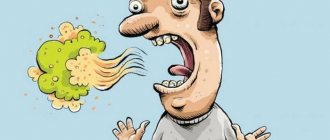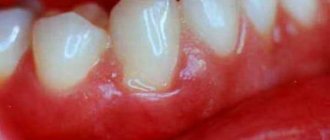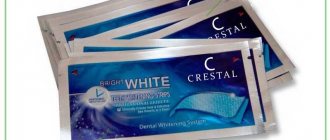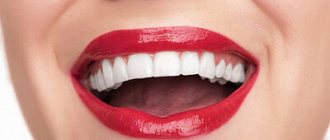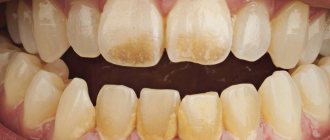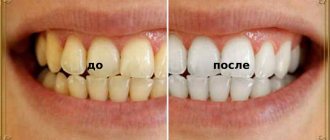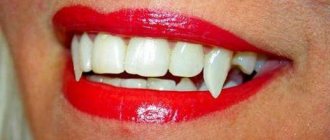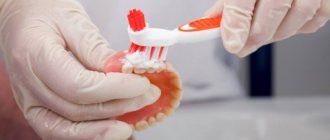When an adult’s tooth hurts and becomes loose, it is always pathological in nature and is not considered normal. Why do teeth become loose in adulthood?
There is a whole list of reasons:
- Gum pathologies. Inflammatory and infectious diseases of the oral cavity - periodontitis, gingivitis. They make the gums weak and cause bleeding. The tooth root weakens and the teeth begin to hurt and move.
- Hidden chronic diseases. Sometimes a tooth hurts and becomes loose due to hidden chronic pathologies. For example, with inflammatory processes in the joints, including jaw joints, arthrosis, endocrine disorders, weakening of the cardiovascular system, calcium deficiency, tumors.
- Carrying a child. Hormonal imbalance and a decrease in the amount of calcium in the blood can lead to loosening of molars and their loss.
- Mechanical damage. Impacts, scratches and other damage to the jaws can cause loosening. Especially if inflammation has developed in the area of damage.
You can strengthen loose molars by regularly using preventive measures:
- Periodically clean from stones and plaque.
- Quit smoking.
- Eat fully and correctly.
- Clean your teeth with strengthening agents.
- Do not start inflammation in the oral cavity.
- Take calcium supplements.
In addition, you need to undergo a dental examination at least once a year.
If the tooth is a little loose
If your teeth have just begun to loosen, then you need to urgently take preventive measures. If you don’t know why your teeth have become loose, then it’s better to see a doctor for control.
What to do after being examined by a doctor:
- Brush your teeth and rinse your mouth twice a day.
- Correct the bite if there is deformation.
- Monitor the condition of your gums.
- Eat right, including vegetables, fruits and foods rich in fluoride and calcium in your diet.
These methods will help strengthen your teeth and prevent further loosening.
How to protect bone from atrophy: treatment of periodontitis and periodontal disease
Over decades of dental research and practice, many methods have been found to treat gums, dental ligaments and jaw bones with periodontitis and periodontal disease. In recent years, developments in microbiology and advances in the field of periodontics and biomaterials have brought the latest effective developments and drugs. Some time ago, periodontitis was considered an irreversible disease, and even at the initial stage it was necessary to take into account the fact that with all methods of treatment and prevention, a temporary result was achieved, albeit for a long time - for several years. Today, the first two stages of the disease can be successfully treated in adults and children, as well as restoration of bone and gum levels thanks to advanced methods and drugs.
To achieve results in restoring oral health, an integrated approach is essential. To treat this disease, you cannot choose just one effective and proven method, since you need to influence the problem from all sides: it is important to eliminate the cause, stop the inflammatory process and subsequently restore the periodontium and ligamentous apparatus.
However, at the third chronic stage of the disease, considerable treatment efforts are, as a rule, insufficient to completely eliminate the disease, and the only solution remains to remove the remaining affected teeth as the source of inflammation and the focus of the disease.
Periodontal disease has a different clinical picture, and the treatment of this disease is based on other methods. Let's look at them in more detail later in the article.
Part of the molar is movable
Teeth can become loose and fall out in parts. When half a tooth is loose, the dentist takes an x-ray to determine whether the root is affected or only the outer part of the crown is damaged. If the root is not damaged and the base is preserved, then it can be saved. The upper part of the crown is removed and a pin is installed in its place. Then extension is carried out. If the pin cannot be placed, then a polymer filling is placed, and a crown is placed on it. When a tooth becomes very loose and the root is crushed, it is removed and an artificial crown is placed in its place.
Degrees of mobility
- I
– the tooth deviates back and forth from neighboring units
by no more than 1 mm
, there are no symptoms from the periodontium or gums; - II
– amplitude of swing back and forth and sideways
by 1 mm or more
, tartar and plaques are visible on the enamel, redness, swelling, bleeding and soreness of the gums are possible; - III
– the teeth swing strongly in any direction with slight pressure with the tongue or chewing, the amplitude of the displacements
significantly exceeds 1 mm
; - IV
– the tooth shifts in all planes, rotates around its axis, and
barely stays
in the gum tissue.
Pathological mobility of any degree requires complex treatment. If the tooth is located in the gum, the periodontium and socket are intact, the process is reversible. Dental units begin to become very loose when periodontitis or periodontal disease is advanced. With deep periodontal damage, weakening and destruction of the ligamentous apparatus, bone atrophy, tooth extraction may be required, followed by implantation and prosthetics.
What to do after a blow
Dental bruises are closed injuries received after strong mechanical impact. (hitting a hard object). In this case, the teeth remain in place, do not move, but may begin to move. The front ones are especially vulnerable. If your front tooth becomes loose after an impact, you should immediately consult a doctor so that you can save it. X-rays and electroodontodiagnosis are prescribed. The latest diagnostic method makes it possible to see the beginning of the development of tissue necrosis and remove dying particles to prevent inflammation.
As a rule, medications are not used for tooth bruises. Swelling of the gums is relieved with cold compresses, and the patient must be on a liquid diet for some time to keep the molar at maximum rest. Sometimes, dentists practice grinding the cutting edge of the tooth and the cusps of the opposite tooth on the lower jaw, which the patient touches when chewing food.
Surgery
In case of severe gum loss, the only effective way to restore it is soft tissue surgery. Today, several surgical techniques are actively used.
| Methodology | Description |
| Flap reconstruction | Gum plastic surgery, when its deficiency is compensated with the help of a donor flap, which is taken from neighboring areas. If the patient’s gums have dropped slightly (by 2-3 mm), this method can be used to quickly restore its previous level. Disadvantages of the technique are traumatic and aesthetic defects (there may be a discrepancy in color between the donor and native areas) |
| Tissue regeneration using plasma lifting and PRF membranes | A more modern technique that does not require taking donor tissue. Injections of plasma and/or installation of fibrin membranes are made into the affected area. This starts the process of tissue regeneration. The treatment is longer compared to the first method, but it is effective and less traumatic |
| Installation of a collagen implant | A minimally invasive technique that is effective for tissue restoration after periodontal disease or age-related gum atrophy. Such implants contain an analogue of connective tissue, which helps restore gums |
| Classic implantation | What to do if the gums have receded, the tooth root is exposed, and the doctor says that tooth extraction is no longer possible? The best solution in this case would be bone grafting and the installation of dental implants. This is the only way to effectively replace lost teeth. In some situations, additional soft tissue plastic surgery may be required. |
In case of mechanical damage, receding gums can be raised using classic surgery with sutures. This is only possible if there are no serious injuries that require additional measures. It is important that surgical treatment is also aimed at eliminating visual defects. To deal with the root cause, comprehensive treatment is required, especially in cases where periodontal diseases develop against the background of problems with the functioning of other body systems.
If the root one is unsteady
Often a healthy tooth begins to hurt sharply and become loose. Permanent teeth can also become loose, even if they are molars. You don’t need to endure it, but go to the dentist. The doctor prescribes disinfectants: rinsing with chlorhexidine and furatsilin solution, gel applications.
If the gums are inflamed, then anti-inflammatory and regenerating drugs are prescribed. (“Trental”, “Olazol”, etc.). Physiotherapy also helps stop the process. For example, vacuum massage, darsonval, ultrasound procedures.
After stopping the inflammatory processes in the oral cavity, the dentist strengthens the teeth in the correct position and applies a temporary splint. If a wisdom tooth is loose and hurts, it is most often removed since it does not play a special role in the chewing process.
How diseases arise - features and differences
The reasons are the main thing that distinguishes these diseases. In most cases, inflammation of the gums and periodontitis are caused by prolonged accumulation of bacterial plaque and stone on the enamel and under the gums. It is poor and irregular oral hygiene that initially provokes slight inflammation of the gums, and its penetration deep into the tissue is a matter of time. Pathogens and mechanical trauma to the mucous membrane lead to irreversible processes in the periodontium[2].
Insufficient and unsatisfactory oral hygiene is the main, but not the only cause of the disease. A share of 10% falls on general diseases of the body, which serve as an impetus for the development of pathology, namely diabetes, osteoporosis, leukemia and others.
What is the difference between periodontal disease and periodontitis in dentistry? In addition to the terms and manifestations themselves, the difference is also in the reasons, which are not fully understood. On the one hand, the disease is non-inflammatory in nature and is caused by metabolic disorders. It is known that periodontal disease begins not from the gums, but from the bone parts of the jaw, where sclerosis of the feeding vessels occurs - a reduction in the diameter of the vascular tubes. For this reason, the supply of oxygen and necessary substances to all tissues is disrupted, which leads to the gradual death of cells. Most often, this is how the first (mild) stage of this disease develops. However, the next two are interrelated with periodontitis and are its consequence.
Also, long-term and conservative treatment of gum inflammation leads to periodontal disease, in which the infectious component is removed, but nothing is done to restore tissue (in the moderate and severe stages).
Front
The upper front teeth are very mobile, so they often begin to wobble. To find out the reason for this, a comprehensive examination is carried out, including a panoramic photograph of the oral cavity. What to do if your front molar is loose?
After determining the causes, a complete sanitation of the oral cavity is required to destroy infectious pathogens. If periodontal disease is detected, the specialist performs a special massage on the gums, darsonval procedures. If signs of periodontitis are detected, then be sure to remove stones and plaque, and polish the teeth with an ultrasonic beam. The entire surface of the tooth, including the neck, is polished with a brush using medical varnish containing fluoride.
Difficult deposits are removed with curettes, which pass under the gums, pulling out deposits. Open curettage is also performed, where the gum is cut and then stitched back together. Additionally, medications are prescribed that relieve inflammation with an antiseptic effect.
If the upper front teeth of an adult are seriously damaged or separated, a splint is placed on the upper jaw. A small hole is drilled in the molar into which fiberglass is placed. After which everything is covered with any composite substance that reflects light rays. Thus, during the movement of the front jaw, the molars do not move apart.
In the event of a mechanical injury, when part of the crown is broken and the tooth root is damaged, all fragments are removed and artificial crowns are installed in place of the natural tooth. The sooner a patient contacts a dentist with a problem, the higher the success of treatment. In complex cases, surgery may be required.
Advantages of visiting Dr. Martin dentistry
The network of dental clinics "Doctor Martin" was awarded the honorary title of dentistry with European quality of treatment. Despite this, the pricing policy is loyal, the cost of the services provided is affordable, discounts and special offers are regularly held (more details on the price list can be found on the website). Every patient is guaranteed free consultations.
To make an appointment with a specialist, you can contact the administrator at the numbers provided or leave a request on the website. At the initial appointment, the doctor will collect an anamnesis, conduct an examination,, if necessary, prescribe a diagnosis and tell you how to save a loose tooth in a particular case. Thanks to the extensive experience and highly qualified specialists, it is possible to cope with even advanced clinical situations. Don't delay, make an appointment right now!
What to do if your teeth are loose and your gums hurt
When gums bleed and become inflamed, teeth can also become loose and even fall out. One of the factors that provokes this condition is acute or chronic gingivitis. The inflammatory process provokes a light plaque on the teeth consisting of microbial pathogens or the formation of tartar on the teeth if you do not take good care of the oral cavity. If gingivitis is not treated, the germs travel deeper into the tissue. Periodontitis develops when pus forms on the gums, the necks of the teeth are exposed, and constant pain appears.
With periodontitis, the inflammatory process occurs in the tissues, from the base of the tooth root. At the same time, gumboil appears and the gums become very swollen and painful. Sometimes, due to chronic infection, cysts form on the gums; they do not appear immediately. In severe cases, a granuloma forms on the gums, in which bacteria attack the gums and roots of the teeth. In this case, the person experiences severe itching and high fever.
Also, gums can hurt after tooth extraction, installation of implants, braces, appliances, or improper dental treatment.
If your teeth are loose in your gums, you should not:
- Press your finger on the gum
- Heat with compresses, sand, warm rinses
- Open an abscess at home
- Taking too many painkillers
First of all, you need to relieve pain with pills or injections. But under no circumstances should you exceed the dosage. Paracetamol, analgin, ketanol and other similar products are suitable. You can also use gels with an analgesic and cooling effect.
You can rinse your mouth with Chlorhexidine and Miramistin. This needs to be done in the morning at lunch and in the evening to get results.
Pharmaceutical preparations to strengthen gums
Strengthening the gums is carried out by rinsing 3 times a day with solutions of essential oils (3 grams per 1 glass of water):
- tea tree;
- fir;
- sea buckthorn;
- eucalyptus;
- peppermint.
Compresses with these oils on loose areas are useful.
Medicines and pills
If a person does not believe in traditional methods of strengthening the loose tissues of the mouth and the bone tissues of the teeth, tablets (multivitamins, antioxidants - Mexidol, anti-inflammatory - Analgin), ointments, gels, rinses are at his service.
Vitamins to strengthen gums
Tablet vitamins quickly eliminate the deficiency of necessary substances than organizing a nutritious diet. To strengthen the gums, complexes containing A, B6, B12, C, D, E, phosphorus, calcium for normal metabolism are more useful.
Ointments for weak gums
To prevent teeth from becoming loose, ointments are used to treat gums when loosening begins. Troxevasin strengthens the wall of blood vessels. Heparin ointment stops bleeding and any inflammation, improves microcirculation.
Gels to strengthen loose gums
The dentist should advise how to strengthen the gums – which gel – so as not to harm the loose mucous membrane.
Known gels:
- Asepta.
- Holisal.
- Solcoseryl.
- Metrogyl denta.
- Dental.
- Kamistad.
Some of them only have an anti-inflammatory effect, others additionally strengthen, anesthetize, heal, and disinfect.
Rinse aids
To prevent infection of the loose area after eating, rinsing with a weak solution of potassium permanganate is useful, or use:
- Furacillin.
- Chlorhexidine.
- Hydrogen peroxide.
- Chlorophyllipt.
- Stomatophyte.
- Maraslavin.
- Miramistin.
- Mexidol dent.
- Forest balm.
- President classic plus.
All of them have anti-inflammatory and antiseptic effects, and a number of them have hemostatic effects (hydrogen peroxide, Maraslavin).
Rinse aids containing alcohol should not be used by adults who are about to drive a car or by children.
Strengthening with toothpaste
Medicinal toothpaste for strengthening gums and teeth is purchased at the pharmacy. It is not available in supermarkets.
Toothpastes, the components of which strengthen loose tissues, if teeth are loose, will be recommended by the dentist, taking into account the specific condition of the oral cavity (excess or lack of substances, acidity):
- Paradontax contains many minerals (F, Na, Zn) and plant extracts.
- Lacalut – herbal ingredients, sodium fluoride, aluminum lactate.
- VIVAX – complex of amino acids, betulavit.
- Mexidol Dent Active is an antioxidant.
Pastes are used to eliminate inflammation of loose areas and in preparation for operations on the oral organs.
How effective are gum injections?
Injections into the loose soft tissues of the mouth are effective for quickly relieving inflammation. They are carried out by professional dentists, since each drug has contraindications and the risk of complications. Enter:
- broad-spectrum antibiotics or according to the detected sensitivity of bacteria to them, course – 5–7 days;
- biogenic stimulants (Lidase, FIBS, Aloe extract) to accelerate healing, 1 month;
- antitoxic serums with antibodies to bacterial exotoxins;
- sclerosants (chromium alum, urethane quinine, 40% glucose solution) to strengthen the loose zone;
- Ribonuclease and Methyluracil to stimulate vascular growth;
- plasmolifting – injections into the gums of the patient’s own blood plasma, the most hypoallergenic method, increases immunity, accelerates healing;
- immunomodulators (thymalin, thymogen, galavit, pyrogenal);
- vitamin complexes.
Therapy is carried out taking into account the needs of the individual patient.
